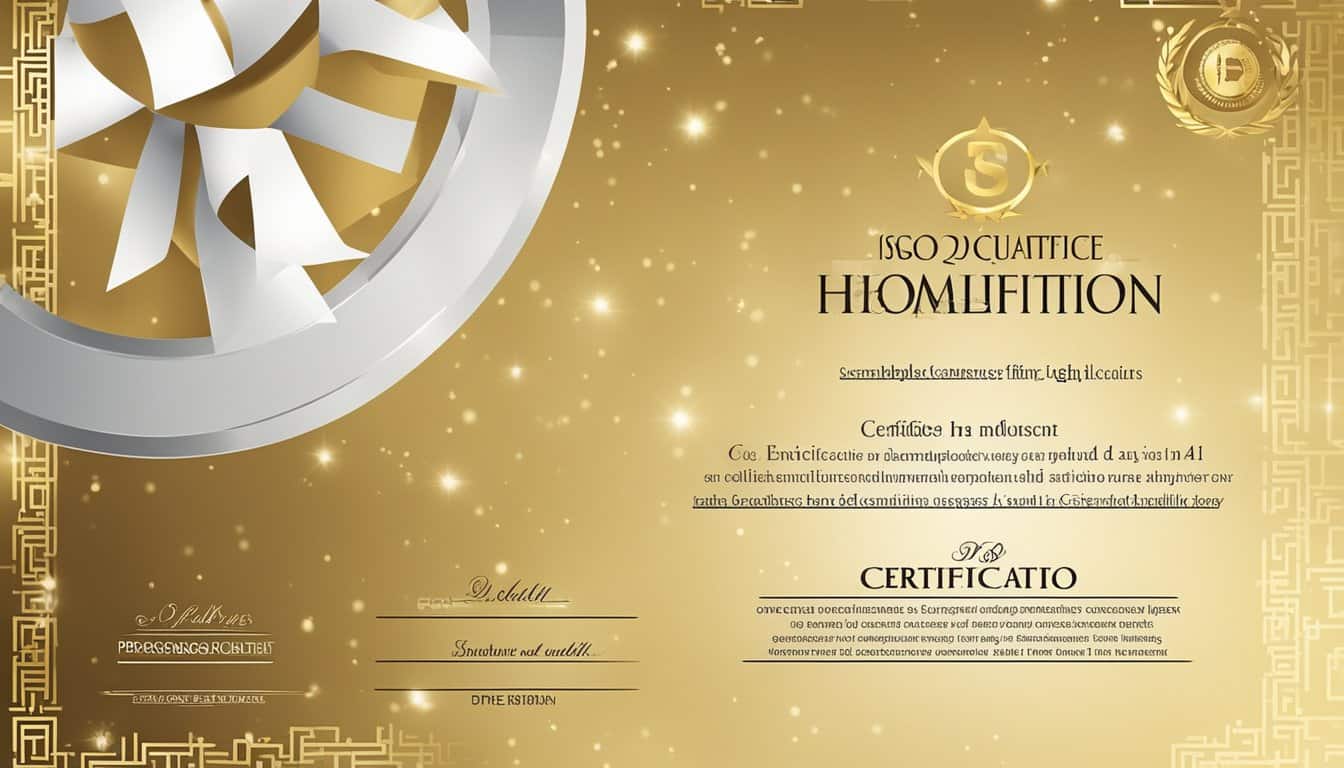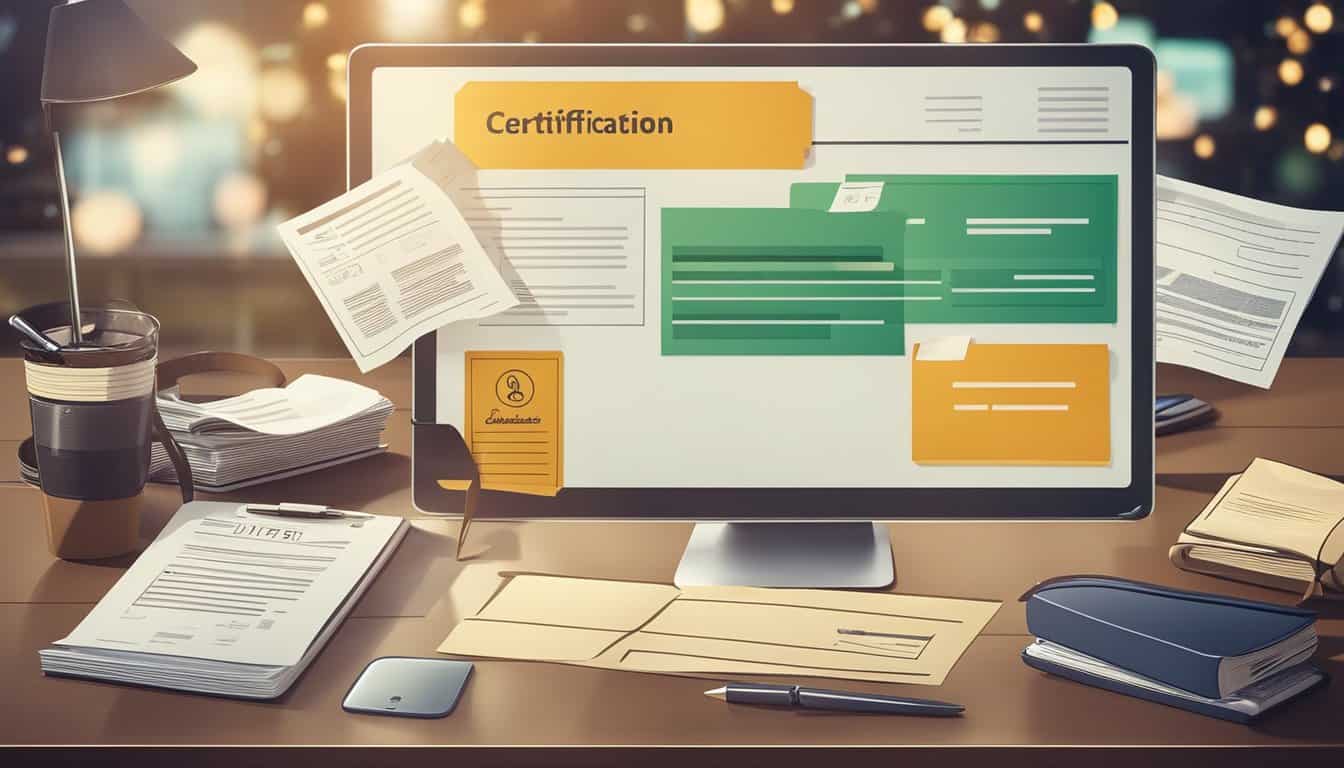Understanding ISO Certification For Your Business
If you’re a business owner or manager, you’ve likely heard of ISO certification. But what exactly is it, and why is it important? ISO certification is a process that verifies a company’s adherence to international standards for quality management, environmental management, and other areas. It’s a way for businesses to demonstrate their commitment to excellence and to ensure that their products and services meet the highest possible standards.

Understanding ISO Certification ISO certification involves a rigorous process of evaluation, documentation, and auditing to ensure that a company’s management systems meet the requirements of the relevant international standard. This process is carried out by an independent certification body, which assesses the company’s systems and issues a certificate if they meet the requirements. The certification is valid for a set period of time, after which the company must undergo a recertification process to maintain its certification.
Key Takeaways
- ISO certification is a process that verifies a company’s adherence to international standards for quality management, environmental management, and other areas.
- The certification process involves a rigorous evaluation, documentation, and auditing process carried out by an independent certification body.
- ISO certification is an important way for businesses to demonstrate their commitment to excellence and to ensure that their products and services meet the highest possible standards.
Understanding ISO Certification

If you are looking to improve your business’s efficiency, quality, and customer satisfaction, then ISO certification may be just what you need. ISO certification is a globally recognized standard that demonstrates that your business is meeting specific requirements for quality management systems. In this section, we will explore the history and evolution of ISO standards and the types of ISO certifications available.
History and Evolution of ISO Standards
The International Standards Organization (ISO) was founded in 1947 and has since become the world’s largest developer of voluntary international standards. ISO standards cover a wide range of industries, including manufacturing, healthcare, and technology. ISO standards are developed by experts from around the world and are designed to improve product quality, safety, and efficiency.
Types of ISO Certifications
ISO 9001 is the most widely recognized and sought after ISO certification. It is a standard that outlines the requirements for a quality management system. ISO 9001 certification demonstrates that your business is committed to meeting customer needs, improving efficiency, and continuously improving your products and services.
Other types of ISO certifications include ISO 14001, which focuses on environmental management systems, and ISO 27001, which focuses on information security management systems. There are also industry-specific ISO certifications, such as ISO 13485 for medical devices and ISO/TS 16949 for the automotive industry.
In conclusion, ISO certification is a powerful tool for businesses looking to improve their quality management systems and demonstrate their commitment to customer satisfaction. By achieving ISO certification, you can improve your business’s efficiency, reduce waste, and increase customer satisfaction.
The Certification Process

Getting your business certified with ISO is an exciting step towards improving your business practices and demonstrating your commitment to quality. The certification process can seem daunting, but with the right preparation, it can be a smooth and efficient process.
Steps to Certification
To get started, you will need to develop a quality management system (QMS) that meets the requirements of the relevant ISO standard. This will involve identifying core business processes, studying them, and determining where to make improvements. Work with managers and teams at all levels and document their processes. Once you have developed your QMS, you will need to verify that it’s working through an internal audit.
The next step is to undergo a certification audit by a third-party registrar. The registrar will review your QMS documentation, conduct an on-site audit of your operations, and verify that your QMS meets the requirements of the relevant ISO standard. If your QMS is found to be in compliance, you will be issued an ISO certificate.
Choosing Certification Bodies
When choosing a certification body, it’s important to evaluate several certification bodies to find the one that best meets your needs. Check if the certification body uses the relevant CASCO standard and if it is accredited. Accreditation provides independent confirmation of competence.
The Role of Accreditation
Accreditation is an important part of the certification process. Accreditation bodies are responsible for assessing the competence of certification bodies and ensuring that they meet international standards. Accreditation provides assurance that the certification body is competent to carry out the certification process and that the certificates issued are credible.
In conclusion, the certification process involves developing a QMS, verifying that it’s working through an internal audit, and undergoing a certification audit by a third-party registrar. It’s important to choose a certification body that uses the relevant CASCO standard and is accredited. Accreditation provides assurance that the certification body is competent to carry out the certification process and that the certificates issued are credible.
Benefits of ISO Certification

If you are considering obtaining ISO certification for your business, you are on the right track. ISO certification can provide numerous benefits to your organisation, your customers, and your industry. In this section, we will explore some of the key benefits of ISO certification.
Enhancing Credibility
ISO certification can add credibility to your business by demonstrating that your products or services meet the expectations of your customers. Certification can be a useful tool to add credibility, by demonstrating that your product or service meets the expectations of your customers. It can help your business to stand out from competitors and give customers peace of mind knowing that you are committed to quality and continuous improvement.
Improving Efficiency and Product Quality
ISO certification can help your business streamline its operations and improve the quality of your products. The certification process requires you to identify and document your processes, which can help you to identify areas for improvement. By improving your processes and ensuring that your products meet the requirements of your customers, you can enhance your reputation and increase customer satisfaction.
Marketability and Competitive Advantage
ISO certification can help your business to stand out in the marketplace and gain a competitive advantage. By demonstrating your commitment to quality and continuous improvement, you can attract new customers and retain existing ones. ISO certification can also help you to enter new markets and expand your business.
In conclusion, ISO certification can provide numerous benefits to your business, including enhancing credibility, improving efficiency and product quality, and gaining marketability and competitive advantage. By obtaining ISO certification, you can demonstrate your commitment to quality and continuous improvement, which can help you to attract and retain customers and grow your business.
ISO Management Principles

If you are seeking ISO certification, understanding the ISO management principles is essential. These principles provide a framework for organisations to improve their performance and meet customer requirements. ISO 9001:2015 identifies seven management principles that are fundamental to quality management. In this section, we will discuss three of these principles: Leadership and Commitment, Customer Focus, and Engagement of People.
Leadership and Commitment
Leadership is a crucial component of any quality management system. It sets the tone for the organisation and provides direction for employees. According to ISO, leaders should establish and communicate a shared vision and values, create a culture of trust and integrity, and ensure that the quality policy and objectives are aligned with the organisation’s strategic direction.
To demonstrate commitment to quality management, leaders must allocate appropriate resources, establish and monitor performance metrics, and promote continual improvement. This commitment should be evident at all levels of the organisation, from the executive team to front-line employees.
Customer Focus
Customer focus is another critical management principle. ISO defines customer focus as “understanding and meeting customer requirements, and striving to exceed customer expectations.” This principle requires organisations to identify and understand their customers’ needs and expectations and then design processes to meet those needs.
To ensure customer satisfaction, organisations must monitor customer feedback, respond to complaints and take corrective action as necessary. Implementing a customer-focused approach can lead to increased customer loyalty, improved reputation, and increased revenue.
Engagement of People
Engaging employees in the quality management process is essential to the success of any organisation. According to ISO, engaging people means “enabling their full involvement, empowerment and development to achieve the organisation’s quality objectives.”
Engaged employees are more committed to the organisation’s goals and are more likely to contribute to its success. To engage employees, organisations must create a culture of teamwork and collaboration, provide training and development opportunities, and recognise and reward employee contributions.
In conclusion, understanding the ISO management principles is essential to achieving ISO certification. Implementing these principles can help organisations improve their performance, meet customer requirements, and achieve their strategic objectives. By focusing on Leadership and Commitment, Customer Focus, and Engagement of People, organisations can create a culture of quality that drives continual improvement and enhances customer satisfaction.
ISO in Practice

ISO 9001:2015 is the most widely used standard in the ISO 9000 series and it specifies the requirements for a Quality Management System (QMS). Implementing a QMS ensures that your business consistently meets customer and regulatory requirements, while also improving efficiency and reducing costs.
Quality Management Systems
A Quality Management System is a set of policies, processes, and procedures used to ensure that a company’s products and services meet customer requirements. ISO 9001:2015 provides a framework for implementing a QMS that can help you improve your business operations and achieve your goals.
To implement a QMS, you need to identify your key business processes and develop procedures to ensure that they are performed consistently and efficiently. You should also establish performance metrics to measure the effectiveness of your QMS and identify areas for improvement.
Environmental and Safety Standards
ISO 14001:2015 is the standard for Environmental Management Systems (EMS). It provides a framework for managing your company’s environmental responsibilities, including reducing waste and pollution, conserving resources, and complying with environmental regulations.
ISO 45001:2018 is the standard for Occupational Health and Safety Management Systems (OHSMS). It provides a framework for managing your company’s health and safety responsibilities, including identifying hazards, assessing risks, and implementing controls to prevent accidents and injuries.
Information Security Management
ISO 27001:2013 is the standard for Information Security Management Systems (ISMS). It provides a framework for managing your company’s information security risks, including protecting sensitive data, preventing unauthorized access, and ensuring business continuity in the event of a security breach.
Implementing an ISMS requires identifying your company’s information assets, assessing the risks to those assets, and developing policies and procedures to protect them. You should also establish performance metrics to measure the effectiveness of your ISMS and identify areas for improvement.
Overall, implementing ISO standards can help you improve your business operations, meet customer and regulatory requirements, and achieve your goals.
Maintaining and Improving Certification

Congratulations, you have obtained your ISO certification! But the journey does not end there. Maintaining and improving your certification is just as important as obtaining it. Here are some tips to help you maintain and improve your certification:
Continual Improvement Processes
One of the key principles of ISO certification is continual improvement. This means that you should always be looking for ways to improve your Quality Management System (QMS) and your processes. You can do this by conducting regular reviews of your QMS, identifying areas for improvement, and implementing changes. This will help you to stay ahead of the competition and ensure that your QMS is always up-to-date and effective.
Conducting Internal Audits
Internal audits are an important part of maintaining your ISO certification. They help you to identify any non-conformities or areas for improvement within your QMS. By conducting regular internal audits, you can ensure that your QMS is always compliant with ISO standards and that you are continually improving your processes.
Recertification and Surveillance Audits
ISO certification is not a one-time event. You will need to undergo recertification audits every few years to maintain your certification. These audits are similar to the initial certification audit and will assess your QMS against the ISO standards. In addition to recertification audits, you will also undergo surveillance audits. These audits are conducted annually to ensure that you are still compliant with ISO standards.
To ensure that you are always prepared for recertification and surveillance audits, it is important to maintain accurate records and keep your QMS up-to-date. This will help you to pass the audits with flying colours and maintain your ISO certification.
In conclusion, maintaining and improving your ISO certification is essential for the success of your business. By following these tips and continually improving your QMS, you can ensure that your business stays ahead of the competition and continues to meet the highest standards of quality.
ISO Certification for Various Industries

If you are looking to get ISO certified, you might be wondering if the certification is right for your industry. The good news is that ISO certification is not limited to any particular industry or sector. In fact, there are over 21,000 ISO standards, and each can be adapted to suit the needs of different sectors.
Adapting ISO to Different Sectors
ISO standards can be adapted to suit the needs of different sectors. For example, ISO 9001 is the most widely used standard and is applicable to any organization, regardless of its size, type, or product/service provided. Other ISO standards, such as ISO 14001 for environmental management, ISO 45001 for occupational health and safety, and ISO 27001 for information security management, are specific to certain sectors.
To adapt ISO standards to your sector, you need to identify the specific requirements of your industry. This can be done by conducting a gap analysis to identify the gaps between your existing processes and the requirements of the standard.
Case Studies and Success Stories
ISO certification has been successfully implemented in various industries, including manufacturing, healthcare, agriculture, food safety, technology, and utilities. For example, a manufacturing company in the UK implemented ISO 9001 and ISO 14001 and saw a 30% increase in productivity and a 25% reduction in waste. A healthcare organization in Australia implemented ISO 9001 and saw a 20% increase in patient satisfaction.
ISO certification is not limited to any particular industry or sector. Whether you provide products or services, ISO certification can help you improve your processes, increase efficiency, and enhance customer satisfaction. With the help of global experts, you can adapt ISO standards to suit the needs of your industry and achieve success.
Legal and Regulatory Considerations

If you are considering obtaining an ISO certification, it is important to be aware of the legal and regulatory requirements that come with it. In this section, we will explore the two main aspects of legal and regulatory considerations: compliance with international regulations and ISO and national legislation.
Compliance with International Regulations
Compliance with international regulations is an important aspect of obtaining an ISO certification. This includes ensuring that your business meets the requirements of international standards such as ISO 9001 and ISO 14001. These standards provide guidelines for quality management and environmental management, respectively.
In addition to complying with international standards, it is also important to comply with other international regulations. For example, if your business exports products to other countries, you must comply with the regulations of those countries. This may include obtaining certifications or permits specific to those countries.
ISO and National Legislation
Obtaining an ISO certification can also help your business comply with national legislation. Many countries have legislation that requires businesses to meet certain standards related to quality management, environmental management, and other areas. ISO standards can help your business meet these requirements and demonstrate compliance.
ISO certifications can also help your business with conformity and traceability. Conformity refers to the ability to ensure that a product or service meets the specified requirements. Traceability refers to the ability to trace a product or service back to its source and ensure that it meets all the necessary requirements.
In summary, obtaining an ISO certification can help your business comply with international regulations, national legislation, and ensure conformity and traceability. It is important to be aware of these legal and regulatory considerations when pursuing ISO certification.
Support and Resources

If you are thinking about getting ISO certified, you should know that there are many resources available to help you. ISO 9001 and other ISO standards require that you have certain resources in place to support your quality management system. This includes training and education for employees, as well as guidance for businesses.
Training and Education
One of the most important resources you will need is training and education. Your employees need to understand the ISO standard you are working with, and they need to know how to implement it in their day-to-day work. There are many training courses available that can help you with this.
ISO training courses cover a wide range of topics, including quality management, environmental management, and occupational health and safety. These courses are designed to help you understand the ISO standard you are working with and how to implement it in your organization. They can be delivered in a variety of formats, including classroom training, online courses, and on-site training.
Guidance for Businesses
Another important resource you will need is guidance for businesses. Implementing an ISO standard can be a complex process, and it can be difficult to know where to start. Fortunately, there are many resources available to help you.
ISO provides guidance documents that can help you understand the requirements of the standard you are working with. These documents are designed to help you implement the standard in your organization and ensure that you meet all the requirements. ISO also provides a range of tools and resources to help you implement your quality management system, including templates, checklists, and guidance documents.
In addition to ISO’s resources, there are many other organizations that can provide guidance and support. For example, there are many consulting firms that specialize in helping businesses implement ISO standards. These firms can provide you with expert guidance and support throughout the implementation process.
Overall, there are many resources available to help you implement an ISO standard in your organization. With the right training, guidance, and resources, you can ensure that your quality management system is effective and efficient.
Performance Evaluation and Monitoring

ISO certification is a valuable asset for any business, but achieving it is only the beginning. To maintain your certification, you must continually evaluate and monitor your performance. This section will cover the key aspects of performance evaluation and monitoring that you need to consider.
Measuring Success
Measuring success is a critical aspect of performance evaluation. You need to set clear objectives and targets for your business, and then regularly measure your progress against them. This will help you identify areas where you are excelling and areas where you need to improve.
One effective way to measure success is by using Key Performance Indicators (KPIs). KPIs are specific metrics that you use to track progress towards your objectives. For example, if one of your objectives is to improve customer satisfaction, you might use KPIs such as customer retention rate, customer feedback scores, and response time to customer complaints.
Regularly reviewing your KPIs will help you identify trends and patterns in your performance. This will enable you to make informed decisions about where to focus your efforts to improve your business.
Feedback and Customer Satisfaction
Customer satisfaction is a critical component of any successful business. It is essential to regularly gather feedback from your customers to understand their needs and expectations. This will help you identify areas where you need to improve your products or services.
One effective way to gather feedback is by conducting customer surveys. Surveys can be conducted online, by phone, or in person. The key is to ask targeted questions that will provide you with actionable insights.
Another way to gather feedback is by monitoring customer complaints. By tracking complaints, you can identify patterns and trends in customer dissatisfaction. This will enable you to take proactive steps to address the underlying issues.
Regularly reviewing customer feedback and complaints will help you identify areas where you can improve your business. This will enable you to provide better products and services, which will ultimately lead to increased customer satisfaction and loyalty.
Risk Management and Planning

ISO certification is a process that involves various stages, including risk management and planning. The aim of this section is to provide you with an overview of the risk management and planning process for ISO implementation.
Strategic Planning for ISO Implementation
Strategic planning is a critical step in the ISO implementation process. It involves identifying the goals and objectives of your organisation and aligning them with the requirements of the ISO standard. This process requires the involvement of top management to ensure that the implementation process is successful.
During the strategic planning phase, you need to identify the risks that your organisation faces. This process should involve a comprehensive risk assessment that considers both internal and external factors. Once you have identified the risks, you need to develop a risk management plan that outlines how you will mitigate or manage these risks.
Risk Assessment and Mitigation
Risk assessment is a critical component of the ISO implementation process. It involves identifying potential risks that could impact your organisation’s ability to achieve its objectives. Once you have identified the risks, you need to evaluate their likelihood and impact. This will help you prioritise the risks and develop a risk management plan that addresses the most significant risks first.
The risk management plan should include strategies for mitigating or managing the identified risks. This could include implementing controls, transferring the risk, or avoiding the risk altogether. It is essential to monitor the effectiveness of the risk management plan regularly. This will help you identify any gaps or areas for improvement and adjust the plan accordingly.
In conclusion, risk management and planning are critical components of the ISO implementation process. By developing a comprehensive risk management plan and aligning your goals and objectives with the requirements of the ISO standard, you can ensure a successful implementation process.
The Future of ISO Standards

ISO standards have been instrumental in promoting global trade, driving innovation, and advancing health and safety. As technology continues to evolve and the world faces new challenges, ISO is committed to staying at the forefront of industry trends to ensure that their standards remain relevant and effective. In this section, we will explore some of the exciting developments on the horizon for ISO certification.
Innovation and ISO
Innovation is a key driver of progress, and ISO is no stranger to this concept. In fact, ISO has been at the forefront of developing standards for emerging technologies such as autonomous vehicles, artificial intelligence, and blockchain. One example of this is the BSI Flex initiative, which has helped establish a common language and consistent way of defining terms for the rapidly developing technology of connected and autonomous vehicles (CAVs) [1].
ISO is also exploring ways to make their standards more accessible and user-friendly. The ISO SMART project aims to revolutionize the way that standards are accessed and used, streamlining digital collaboration and enabling measurable progress in tackling climate change through the Net Zero Guidelines [2].
Sustainability and ISO Standards
Sustainability is a growing concern for businesses and consumers alike, and ISO is rising to the challenge. ISO standards have been developed to promote sustainable practices in a variety of industries, from energy management to sustainable tourism.
One such standard is ISO 14001, which provides a framework for environmental management systems. This standard helps organizations to reduce their environmental impact, comply with regulations, and improve their overall environmental performance [3]. Another example is the ISO 26000 standard, which provides guidance on social responsibility and sustainable development [4].
ISO is also committed to promoting sustainability within their own organization. The ISO logo has been updated to include a green leaf, symbolizing their commitment to sustainability and environmental responsibility [5].
In conclusion, ISO standards are constantly evolving to meet the needs of a changing world. With a focus on innovation and sustainability, ISO is well-positioned to continue driving progress and promoting global trade for years to come.
Sources:
[1] https://www.bsigroup.com/en-GB/blog/Organizational-Resilience-Blog/future-of-standards/ [2] https://www.iso.org/ar2022.html [3] https://www.iso.org/iso-14001-environmental-management.html [4] https://www.iso.org/iso-26000-social-responsibility.html [5] https://www.iso.org/news/ref2347.html
Frequently Asked Questions

How can one verify the authenticity of an ISO 9001 certificate online?
You can verify the authenticity of an ISO 9001 certificate online by checking with the certification body that issued the certificate. Most certification bodies have a public database of certified organizations that you can search. You can also check with the International Accreditation Forum (IAF) to ensure that the certification body is accredited.
What are the different types of ISO certifications available for businesses?
There are various types of ISO certifications available for businesses, including ISO 9001 for quality management, ISO 14001 for environmental management, ISO 27001 for information security management, and ISO 45001 for occupational health and safety management.
What are the essential requirements to obtain ISO certification for a company?
The essential requirements to obtain ISO certification for a company include implementing a management system that meets the requirements of the relevant ISO standard, conducting an internal audit, and undergoing an external audit by an accredited certification body.
Can organisations actually get certified in ISO standards at no cost?
No, organizations cannot get certified in ISO standards at no cost. There are costs associated with implementing a management system that meets the requirements of the relevant ISO standard, conducting an internal audit, and undergoing an external audit by an accredited certification body.
What’s the typical cost range for securing ISO 9001 certification?
The cost of securing ISO 9001 certification varies depending on the size and complexity of the organization, as well as the certification body being used. However, the typical cost range for securing ISO 9001 certification can range from a few thousand pounds to tens of thousands of pounds.
Who are the authorised bodies that issue ISO certifications in Singapore?
There are several authorized bodies that issue ISO certifications in Singapore, including TÜV SÜD PSB, SGS, and Bureau Veritas. These certification bodies are accredited by the Singapore Accreditation Council (SAC) and the International Accreditation Forum (IAF).




